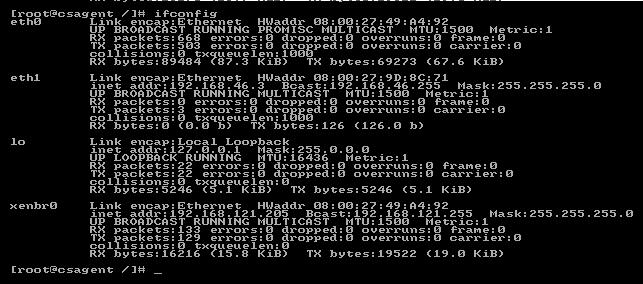Use Vagrant To Manage XenServer
Mar 21, 2016
Technology
Building Templates
Build XenServer 6.2 Template is pretty easy, simply do following:
$ git clone https://github.com/imduffy15/packer-xenserver.git
$ cd packer-xenserver
$ packer build template.iso
After building, check the following box file available under the directory:
$ ls -l -h XenServer.box
-rw-rw-r-- 1 dash dash 708M 3月 21 14:41 XenServer.box
Import box File
Import the generated box file via:
$ vagrant box add XenServer.box --name "XenServer62"
$ vagrant box list | grep XenServer62
XenServer62 (virtualbox, 0)
Start the Virtualbox XenServer
$ mkdir XenServer62
$ cd XenServer62
$ vim Vagrantfile
Vagrant.configure(2) do |config|
# disable mounting of vagrant folder as its not supported on xenserver
config.vm.synced_folder ".", "/vagrant", disabled: true
# disable checking for vbguest versions as its not supported on xenserver
if Vagrant.has_plugin?("vagrant-vbguest")
config.vbguest.auto_update = false
end
config.vm.provider "virtualbox" do |v|
v.customize ["modifyvm", :id, "--memory", 2048]
v.customize [ "modifyvm", :id, "--nicpromisc2", "allow-all" ]
end
config.vm.define :csagent do |csagent|
csagent.vm.box = "XenServer62"
end
end
$ vagrant up
XenServer In libvirt
We want to use XenServer under libvirt(kvm), thus we have to do following changes:
First startup the virtualbox vagrant environment of XenServer, then login to the localhost(127.0.0.1) as root:
$ vagrant ssh csagent
[vagrant@localhost ~]$ ssh root@127.0.0.1
[root@localhost ~]# ifconfig | grep eth0 | grep HWaddr
eth0 Link encap:Ethernet HWaddr 08:00:27:49:A4:92
[root@localhost etc]# ifconfig -a | grep eth1
eth1 Link encap:Ethernet HWaddr 08:00:27:9D:8C:71
Get the Hardware Address(eth0/eth1) via ifconfig, we need them in the following operations.
Now remove the udev items of eth0, eth1 in /etc/udev/rules.d/60-net.rules:
# vi /etc/udev/rules.d/60-net.rules
# Rules generated from static configuration and last boot data
#SUBSYSTEM=="net" KERNEL=="eth*" SYSFS{address}=="08:00:27:49:a4:92" ID=="0000:00:03.0" NAME="eth0"
#SUBSYSTEM=="net" KERNEL=="eth*" SYSFS{address}=="08:00:27:9d:8c:71" ID=="0000:00:08.0" NAME="eth1"
Remove the dynamic rules of the interface renaming:
# vim /etc/sysconfig/network-scripts/interface-rename-data/dynamic-rules.json
# Automatically adjusted file. Do not edit unless you are certain you know how to
{
"lastboot": [
- [
- "08:00:27:49:a4:92",
- "0000:00:03.0",
- "eth0"
- ],
- [
- "08:00:27:9d:8c:71",
- "0000:00:08.0",
- "eth1"
- ]
],
"old": []
}
Should looks like this:
# cat /etc/sysconfig/network-scripts/interface-rename-data/dynamic-rules.json
# Automatically adjusted file. Do not edit unless you are certain you know how to
{
"lastboot": [
],
"old": []
}
Now add the static rules for the XenServer:
$
08:00:27:9D:8C:71
Get the Hardware Address(eth0/eth1) via ifconfig, we need them in the following operations.
Now remove the udev items of eth0, eth1 in /etc/udev/rules.d/60-net.rules:
# vi /etc/udev/rules.d/60-net.rules
# Rules generated from static configuration and last boot data
#SUBSYSTEM=="net" KERNEL=="eth*" SYSFS{address}=="08:00:27:49:a4:92" ID=="0000:00:03.0" NAME="eth0"
#SUBSYSTEM=="net" KERNEL=="eth*" SYSFS{address}=="08:00:27:9d:8c:71" ID=="0000:00:08.0" NAME="eth1"
Remove the dynamic rules of the interface renaming:
# vim /etc/sysconfig/network-scripts/interface-rename-data/dynamic-rules.json
# Automatically adjusted file. Do not edit unless you are certain you know how to
{
"lastboot": [
- [
- "08:00:27:49:a4:92",
- "0000:00:03.0",
- "eth0"
- ],
- [
- "08:00:27:9d:8c:71",
- "0000:00:08.0",
- "eth1"
- ]
],
"old": []
}
Should looks like this:
# vim /etc/sysconfig/network-scripts/interface-rename-data/static-rules.conf
eth0:mac = "08:00:27:49:A4:92"
eth1:mac = "08:00:27:9D:8C:71"
Define xenbr0 and eth0 bridging configuration:
# vim /etc/sysconfig/network-scripts/ifcfg-xenbr0
DEVICE=xenbr0
TYPE=Bridge
ONBOOT=yes
NM_CONTROLLED=yes
BOOTPROTO=dhcp
# vim /etc/sysconfig/network-scripts/ifcfg-eth0
DEVICE=eth0
TYPE=Ethernet
ONBOOT=yes
NM_CONTROLLED=yes
BOOTPROTO=none
BRIDGE=xenbr0
Now shutdown the Virtualbox Based XenServer VM via:
[root@localhost network-scripts]# shutdown -h now
Package for Libvirt
Package the modified vbox file and export to libvirt via following steps:
Verify the env is down:
$ vagrant status
Current machine states:
csagent poweroff (virtualbox)
Package the modified vm:
$ vagrant package
==> csagent: Clearing any previously set forwarded ports...
==> csagent: Exporting VM...
==> csagent: Compressing package to: /home/dash/Code/Vagrant/XenServer62/package.box
$ ls
package.box Vagrantfile Vagrantfile~
Mutate to libvirt box:
$ vagrant mutate package.box libvirt
Extracting box file to a temporary directory.
Converting package from virtualbox to libvirt.
(100.00/100%)
Cleaning up temporary files.
The box package (libvirt) is now ready to use.
$ cd ~/.vagrant.d/boxes
$ vagrant box list
XenServer62 (virtualbox, 0)
XenServer62 (libvirt, 0)
Start the libvirt XenServer
Edit the Vagrantfile like following:
# vim Vagrantfile
Vagrant.configure(2) do |config|
# vagrant issues #1673..fixes hang with configure_networks
config.ssh.shell = "bash -c 'BASH_ENV=/etc/profile exec bash'"
config.ssh.username = 'vagrant'
config.ssh.password = 'vagrant'
config.ssh.insert_key = 'true'
config.vm.provider :libvirt do |domain|
domain.nic_model_type = 'e1000'
domain.memory = 384
domain.nested = true
domain.cpu_mode = 'host-passthrough'
end
# csagent node.
# Add one networking, modify hostname, define memory, CPU cores.
config.vm.define :csagent do |csagent|
csagent.vm.box = "XenServer62"
csagent.vm.hostname = CLOUDSTACK_AGENT_HOSTNAME
csagent.vm.network :private_network, :ip => CLOUDSTACK_AGENT_IP, :mac => "08:00:27:9D:8C:71"
# Disable mounting of vagrant folder as it's not supported on xenserver
csagent.vm.synced_folder ".", "/vagrant", disabled: true
csagent.vm.provider :libvirt do |domain|
domain.memory = 8192
domain.cpus = 4
domain.nested = true
domain.cpu_mode = 'host-passthrough'
domain.nic_model_type = 'e1000'
domain.management_network_mac = "08:00:27:49:A4:92"
end
end
end
Start the Vagrant machine via: vagrant up --provider=libvirt.
The result shows XenServer are now running under libvirt:
